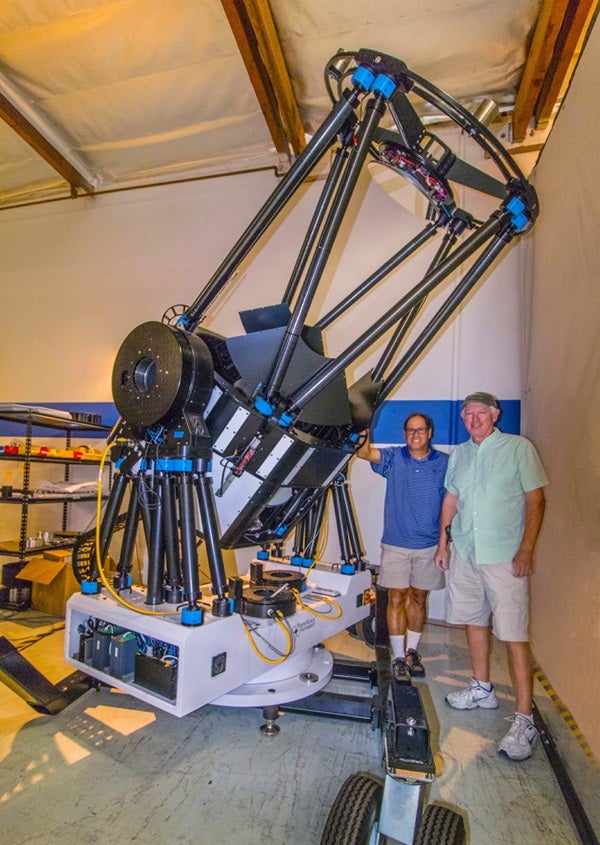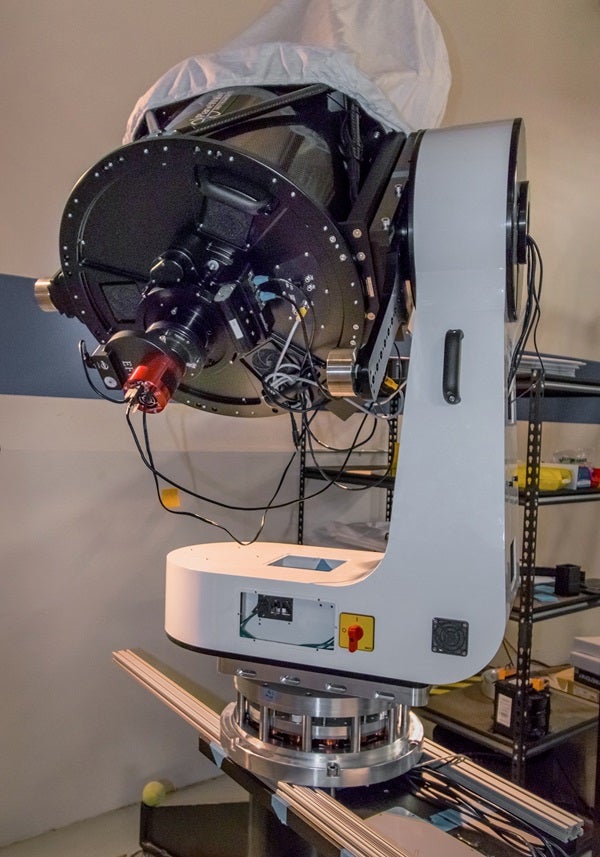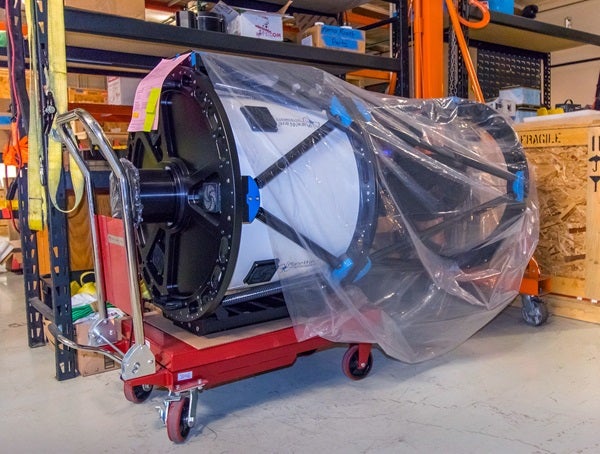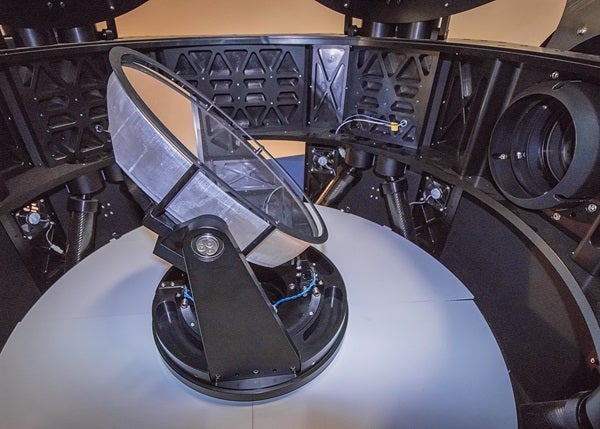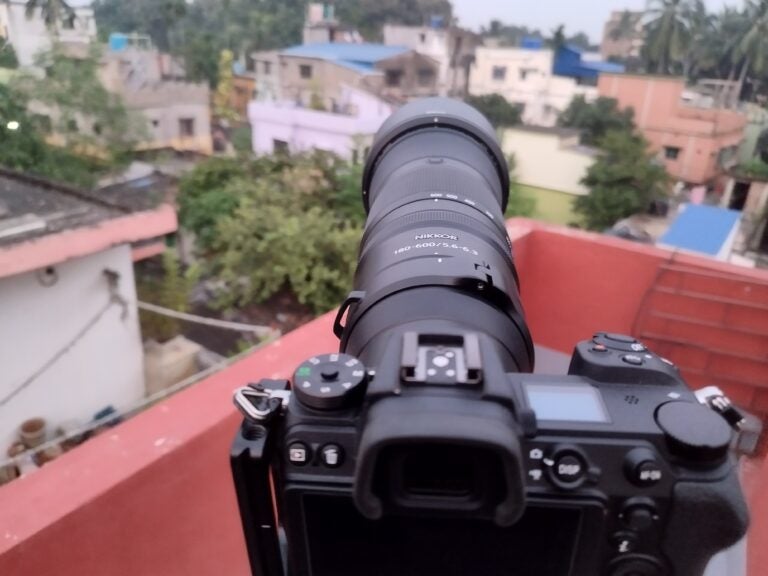Years earlier, while working for Celestron, Joe Haberman and Rick Hedrick had wanted to build a large telescope. Another employee, David Rowe, had an idea for a design he called a corrected Dall-Kirkham (CDK). It addressed the strong off-axis aberrations of the standard Dall-Kirkham design by introducing two corrective lenses into the optical path. Doing so yielded a large, perfectly corrected flat field ideal for imaging.
Haberman, Hedrick, Rowe, and a fourth teammate, Jason Fournier, enrolled in an optics-making course at El Camino College in Torrance, California. They then built by hand the first CDK telescope — one with a massive aperture of 42 inches! Once they had proved the concept, the next step was to see if Celestron could produce CDK telescopes.
The first one the team built was an 18-inch model, followed shortly thereafter by a 20-inch. However, building 20-inch CDK telescopes at Celestron proved impractical. So Hedrick, a partial owner, sold his share of Celestron to David Chen before forming PlaneWave Instruments. Even today, Celestron and PlaneWave remain on very good terms, openly sharing technology and ideas.
From the beginning, Hedrick’s goal was for PlaneWave to make the perfect telescope. Anyone who has tried astrophotography can tell you that there are myriad things that can go wrong. So, to make his instruments “perfect,” he concentrated on five important subjects:
1) Stable optics. Today, PlaneWave offers mirrors made from quartz, a material that is much more thermally stable than the Pyrex mirrors many manufacturers use.
2) Large corrected field. The CDK design allows for a 70-millimeter corrected field — enough to easily cover the detectors in large cameras.
3) Accurate mounts. PlaneWave mounts use encoders to create tracking with virtually zero periodic error. Also, the company’s sophisticated Point XP software models the mount in combination with the telescope and sky.
4) Easy focus. PlaneWave has developed software for its focusers that tests the focus of numerous stars in the field of view and automatically brings the telescope into perfect focus.
5) Fast slewing. Direct-drive motors (with no gears) on some mounts can slew very quickly. Users can also program PlaneWave mounts to follow just about anything in the sky, like satellites or comets. Additionally, Hedrick made certain these mounts have none of the flexure problems of weaker mounts.
The company’s focus has remained on Hedrick’s vision — to create high-end telescopes optimized for astrophotography. PlaneWave offers a specific product line with stable pricing available to amateurs, educational institutions, and the scientific community. Even the company’s enormous 1-meter scope has a set price. There are no surprises when you order a PlaneWave CDK.
Hedrick has brought on board many extremely skilled associates, and the telescopes are a result of this symbiotic team’s numerous different specializations — including optics, mechanical engineering, software, and electronics.
PlaneWave’s staff constantly experiments with new designs and telescopes to bring to the public. At the 2017 Advanced Imaging Conference in San Jose, California, they showed off the company’s new L Mount. This innovative design uses direct-drive motors and can support up to a 24-inch telescope. In the future, the staff foresees computerized optics machines capable of producing mirrors and lenses that meet or exceed the finest hand-figured versions.
To validate the quality of ideas and products, most new products are tested at Rowe’s ranch at Cima Dome in the Mojave Desert. As skilled astrophotographers themselves, it is important to the creators that they use the product before it becomes public.
All the metal pieces for the telescopes are manufactured in Michigan under the watchful eye of Kevin Iott, the company’s chief mechanical engineer. When the metal parts are finished, they are shipped to a facility in California, where assembly and optical manufacturing take place. However, the huge 1m and 700 Series scopes are notable exceptions to this standard procedure. Technicians assemble these in Michigan before shipping them to California, where the optics are installed and final testing occurs.
Would I like a 24-inch CDK that I could operate remotely on some 7,000-foot-high mountaintop with sub-arcsecond seeing and an automated dome? Of course. But for me, imaging is a hobby, and a more modest telescope with a roll-off roof will suffice. What’s great about PlaneWave is that it has a product for everyone, and the quality is the same all up and down the line.
Looking ahead
PlaneWave is striving to reinvent the telescope for the future, just as it has for the past 10 years. Its goal is to bring excellence to both mass and specialized markets. The new technologies that drive the 1m telescope, for example, trickle down to the more modest amateur-sized instruments. And working with the smaller instruments helps develop cost-saving innovations that technicians can apply to the big scopes. Such cross-pollination streamlines the manufacturing of all products, resulting in better telescopes at more affordable prices.
If PlaneWave had a collective motto, it might be “inventing the new frontier.”

